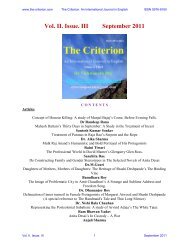Download - The Criterion
Download - The Criterion
Download - The Criterion
Create successful ePaper yourself
Turn your PDF publications into a flip-book with our unique Google optimized e-Paper software.
www.the-criterion.com<strong>The</strong> <strong>Criterion</strong>: An International Journal in EnglishISSN 0976-8165Perhaps, this is what society deems of women! Being physically weak, incapable of any hardlabour and always seen as an object of sensual and physical gratification, women have beenconsidered as ‘frail’.But talking of the women characters in Shakespeare’s tragedies, one will find itextremely difficult to come to their real terms. This is because Shakespeare has never beenable to project the values pertaining to women as human values. His major problem lies in thefact that all his women characters are exceptionally courageous, blunt and scheming or totallymeek, silent and dutiful.Shakespeare’s presentation of women shows his feelings about women and their rolesin society. It is noticed that the ‘upper class women’ are presented as ‘possessions’ of theirfathers and husbands. In most cases, they are socially restricted and unable to explore theworld around them. <strong>The</strong>se women are intimidated and controlled by the men in their lives.Shakespeare shows the ‘lower class women’ to be more aware. <strong>The</strong>y are given morefreedom to explore their sexuality, perhaps because their low-status renders them sociallyharmless. However, women are never totally free in Shakespeare’s plays. If not owned byhusbands and fathers, many low class characters are owned by their employers.Helen Zimmern, in the preface to the English translation of Louis Lewes's study <strong>The</strong>Women of Shakespeare, argued in 1895 that "of Shakespeare's dramatis personae, his womenare perhaps the most attractive, and also, in a sense, his most original creations, so differentare they, as a whole, from the ideals of the feminine type prevalent in the literature of hisday"(vi). Lewes himself strikes a similar tone of praise in his conclusion: "<strong>The</strong> poet's magicwand has laid open the depths of woman's nature, wherein, beside lovely and exquisiteemotion, terrible passions play their dangerous and fatal part"(369).Nevertheless, on careful reading, one may notice that many of Shakespeare’s femalecharacters exercise a rather great deal of power and influence, and often do so in unusual andeven subversive ways that challenge traditional gender roles. Although the male charactersgenerally fail to notice or refuse to acknowledge women’s authority and influence openly,they are undoubtedly affected by it.WOMEN IN THE SELECT TRAGEDIES OF SHAKESPEARE:Shakespeare’s women characters in his tragedies show multiple idiosyncratic characteristics.<strong>The</strong>y are but a whole gamut of binary oppositions. If there is the good, there is the bad; andwith the heroine there is the villain. Again, they are mothers, wives, queens, daughters andlovers; needless to say that some of them are even mistresses. However, a differing stancetaken by Shakespeare form the societal norms is that though he made the male characters theprotagonist of his plays, yet the dominant role has been bestowed upon the females. <strong>The</strong>y arethe ones who shape not only the progress of the plot but also the fate of the men. <strong>The</strong>y arecunning, calculative and enigmatic – they are bold and beautiful; they are beauty and beast!To ascertain their credibility, the women characters of six tragedies of Shakespearehave been studied: Julius Caesar, Hamlet, Othello, King Lear, Macbeth and Antony andCleopatra. All the women characters have different temperaments and reveal different facetsof women at large.Vol. IV. Issue V (October 2013) 3 Editor-In-Chief: Dr. Vishwanath BiteBi-Monthly refereed and Indexed Open Access eJournal
















